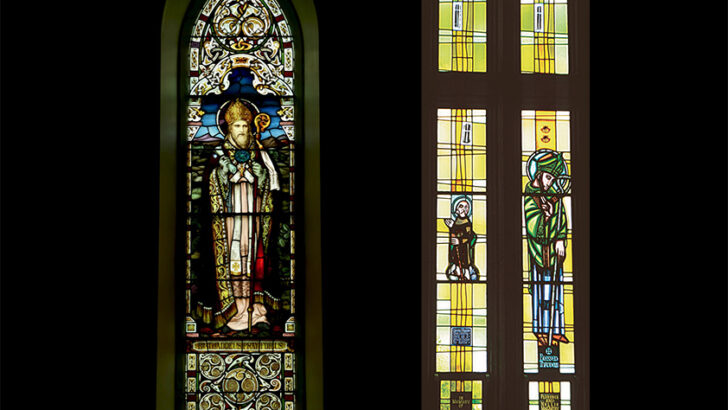Searching for Thaddeus: Images of a Forgotten Irishman in Ireland and Italy, by Patricia Curtin-Kelly (Liberties Press, €20/£18)
This is an interesting and unusual book, which will perhaps lead readers into new places to explore, not only in the remoter parishes of western Munster, but also in northern Italy. It focuses on the city of Ivrea, a place of Celtic origin. It lies in Piedmont on the famous ancient road along which those living in France (and beyond) travelled down to Rome.
Today it is a UNESCO Heritage City and a prosperous industrial town. The ancient cathedral houses shrines to St Bessus and from medieval times, another to St Pierre of Luxembourg.
And also one to Blessed Thaddeus MacCarthy, a man of Celtic origin too, being from western Munster, whose feast day is on October 25. Though he had, so to speak, a previous Irish life, it was only after his death that a devotion to him began to emerge.
He was a bishop twice over in the course of a few years, who never ruled his sees. His appointments to Ross 1482 and later to Cork and Cloyne were mired in controversy, largely down to tribal feuds. Amazingly unable to secure his seat in either place, he went to Rome to receive further authorisation from the pope, setting out in the garb of a pilgrim, wearing the rough robes of penance and the shell emblem of a pilgrimage, to return to Ireland.
Dying in the hostel in Ivrea, he would have been buried in a pauper’s grave but the Bishop Nicholas Garigliatti was summoned. The bishop is said to have had an extraordinary dream during the night in which he had witnessed a man dressed in bishop’s robes ascending in glory to heaven. He immediately recognised the dead man as the person he had seen in the dream.
The man’s belongings were examined – a wallet, a water flask and a staff were his sole possessions. However, the wallet contained some papal documents and a bishop’s ring. Bishop Garigliatti ordered that the body be clothed in bishop’s robes and to be brought to Ivrea Cathedral to lie in state before burial within the cathedral. When news of the death of Bishop MacCarthy traveling in disguise spread, the population flocked to the cathedral of Ivrea for his funeral. After his burial many miracles have been attributed to his intercession.
His tomb became a popular local shrine. In 1742, when it was opened, the body was found to be uncorrupted, in those days taken to be a sign of divine favour.
During Great Famine people in the town sent money for the relief of the hungry people to Ireland. They also began to seek information about this mysterious bishop. A movement began in Piedmont and Munster for his beatification. In 1896 Pope Leo XIII confirmed “the immemorial cult” of the Blessed Thaddeus, so no fresh miracle was needed. Relics were sent from what was then the Kingdom of Italy to Cork.
This is a very strange story. But Patricia Curtin-Kelly is by vocation an art historian. She has already written a volume about the Harry Clarke windows in St Joseph’s Church Terenure. The real heart lies not in the rapidly summarised account of MacCarthy’s saintly life, but in highly illustrated itinerary through her visits to small parish churches in which there are stained glass windows dedicated to him, created by a variety of artists.
This in itself is a very unusual procedure. Most books dealing with stained glass deal with single artists and are published at high prices and in very elaborate formats. This book, however, is within reach of everyone interested in the Blessed Thaddeus.
I can imagine that it may well inspire many happy explorations among Catholic “church-crawlers”, as those with a penchant for church visiting for culture or piety are often called in friendly mockery by those who lack the energy for such a hobby.
Perhaps too it will inspire a more regular popular biography of Thaddeus, dealing in greater detail with what went on in Ivrea. Why, we might wonder today, did the usual movement towards canonisation not take hold?
Could it be that the Irish hierarchy of later Victorian Ireland felt this was an ecclesiastical life that exposed elements of Church history that they preferred were not recounted or over emphasised, as they might challenge the picture being built up of centuries of Irish devotion expressed through Irish bishops.


 Peter Costello
Peter Costello Blessed Thaddeus MacCarthy depicted in a window in St Ita’s church (1907), Gortroe, Co. Cork, installed 1921.
Window in the church of the Holy Family (1903), Caheragh, Co. Cork, installed 1963.
Blessed Thaddeus MacCarthy depicted in a window in St Ita’s church (1907), Gortroe, Co. Cork, installed 1921.
Window in the church of the Holy Family (1903), Caheragh, Co. Cork, installed 1963.